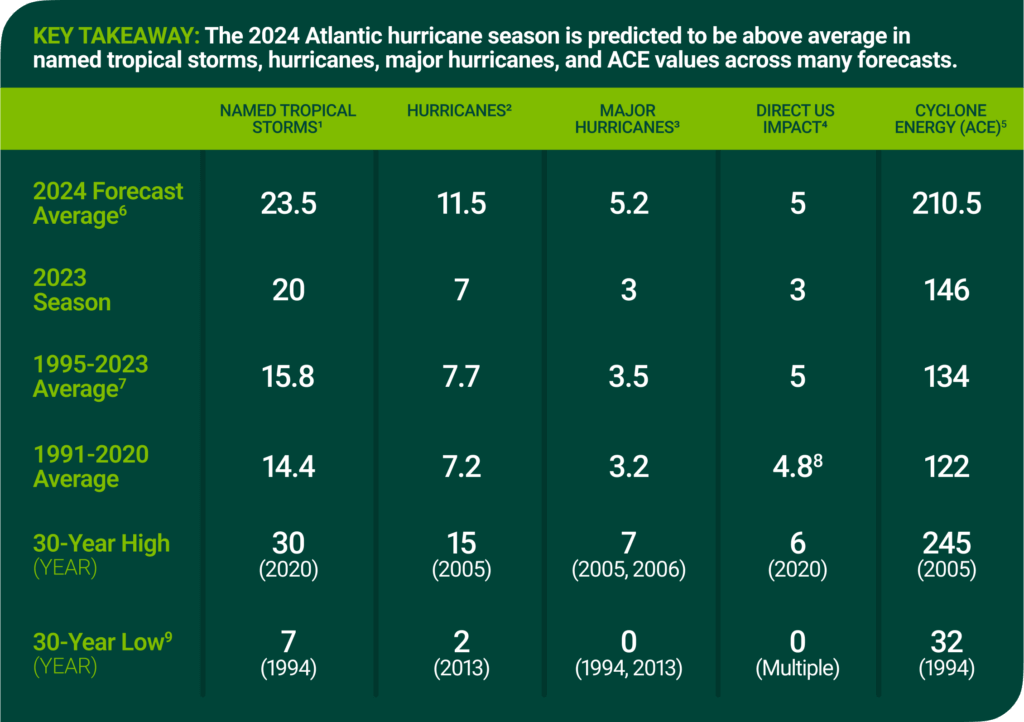Hurricane Season 2024: What's Driving Record-Breaking Forecasts
July 31, 2024 — Disaster insights | Homeowner insights
June 1 marked the start of the 2024 hurricane season—and it’s in full force. At peak strength, Hurricane Beryl made history as the strongest July Atlantic hurricane on record as a Category 5 storm, with max winds of 165 mph before losing strength and making landfall in Texas on July 8 as a Category 1 hurricane.1 Typically, the first major hurricane forms after September 1, according to the National Hurricane Center.2
NOAA National Weather Service forecasters have predicted an 85% chance of an above-normal hurricane activity during the 2024 Atlantic hurricane season.3
In anticipation of the active season, SageSure’s in-house team of cat risk researchers have aggregated all major forecasts in our 2024 Atlantic Hurricane Season Forecast Tracker. This in-depth digest for the upcoming 2024 hurricane season shows above-average named tropical storms, hurricanes, major hurricanes, and ACE (wind energy index) values across multiple forecasts. Most outlooks anticipate a record-setting year that could rival the 2005 and 2020 hurricane seasons.

- Tropical storms have sustained wind speeds of at least 39 mph.
- Hurricanes have sustained wind speeds of at least 74 mph.
- Major hurricanes are Category 3 and above, with a sustained wind speed of at least 111 mph.
- Direct US impact includes landfalling events and events where tropical storm force winds are observed on land, but the center of the storm does not make landfall.
- Accumulated Cyclone Energy (ACE) is a wind energy index defined as the sum of the squares of the estimated 6-hourly maximum sustained wind speed for all named systems while they are at least tropical storm strength. NOAA considers a near-normal season to have an ACE index within 75 130% of the 30-year ACE median.
- When a range was provided for individual forecasts (e.g., 11–15), the mean of the range (e.g., 13) was used to calculate the 2024 forecast average.
- The Atlantic Multi-decadal Oscillation (AMO) has been in a positive/warm phase since 1995 , which includes the 29-year average from 1995-2023. The AMO switches phases every 20-40 years.
- Includes direct US impacts of tropical storm force wind speeds (average of 3.1) as well as the average of landfalling hurricanes (average of 1.7).
- Data from 1994-2023 is included. When using the 30-year period from 1991-2020 , the difference is that 1992 also had a low of 7 named storms.
Key Factors That Influence Hurricane Activity
Several factors are driving forecasters’ predictions: near-record warm temperatures in the Atlantic Ocean, the onset of La Niña conditions in the Pacific, and reduced wind shear are all conducive to increased tropical storm formation.
Let’s dive deeper into the three contributing factors behind the forecasts for a more active hurricane season, and what you can still do to prepare.
Rising Sea Surface Temperatures
With more than 70% of the Earth covered by oceans, sea surface temperatures are powerful indicators of climate activity, including hurricanes. Studies indicate that warmer waters tend to increase storm severity and frequency.
When sea surface temperatures exceed 80 degrees Fahrenheit and the atmosphere experiences weather disturbances, like thunderstorms, hurricanes can form.
Sea surface temperatures are not typically warm enough to support strong hurricanes early in the Atlantic hurricane season. According to NOAA, increasing levels of greenhouse gases are trapping more heat from Earth’s surface, hindering its escape into the atmosphere. As a result, this excess heat is transferred back to the ocean. As sea surface temperatures become unseasonably high, increased hurricane frequency becomes more likely.
Rising sea surface temperatures can also lead to hurricanes that produce 10 to 15% more precipitation, which can cause dangerous flooding. Recent examples include Hurricane Harvey in 2017, which dropped more than 60 inches of rain in some areas; Florence in 2018, with more than 35 inches; and Imelda in 2019, with 44 inches.4
La Niña Conditions
El Niño and La Niña are climate patterns in the Pacific Ocean that have weather impacts worldwide. Outside these conditions, trade winds from the equator move warm water from South America toward Asia. El Niño or La Niña disrupt these patterns and typically occur on average every two to seven years. The wind patterns between the two create a pendulum effect, weakening or strengthening hurricane activity in one region or another.
In simple terms, El Niño tends to increase hurricane activity in the central and eastern Pacific regions while reducing it in the Atlantic region. On the other hand, La Niña usually decreases hurricane activity in the central and eastern Pacific regions and boosts it in the Atlantic region.5
Last year, sea surface temperatures were unusually high, but hurricane activity was below average because El Niño was in effect. This year, however, La Niña increases the likelihood of heightened hurricane activity. In 2020, during the last La Niña, a record-breaking 30 named storms formed, with 11 making landfall in the US.6
Reduced Wind Shear
Wind shear is a variation in wind speed at different heights. Hurricanes cannot form when upper-level winds are too strong. Strong upper-level winds disrupt a storm’s structure by displacing the warm air above the eye and restricting the vertical rise of air parcels.7
El Niño and La Niña affect wind shear, with La Niña conditions producing less wind shear. Low vertical wind shear contributes to hurricane formation, especially in the upper level of the atmosphere. The absence of strong upper-level winds during La Niña makes it easier for hurricanes to develop without outer forces disrupting the formation. NOAAs Climate Prediction Center (CPC) forecasts a greater than 75% chance for La Nina to develop by September.
How to Prepare for an Active Hurricane Season
Hurricane preparation is important every year, but with forecasts anticipating more tropical activity this year, preparation is vital, whether you’re a homeowner or business owner.
Simple steps can help you manage the impact of high winds and floodwater that accompany hurricanes. For instance, did you know that closing the interior doors in your home before you evacuate for a hurricane can decrease the extra load the roof has to bear by up to 30%, according to the Insurance Institute for Business and Home Safety (IBHS).
Be sure to also:
- Check out our simple checklist for more ways to prepare your home, your family, and your important documents for hurricane season.
- Find a more in-depth guide for preparing your home’s structure for hurricane season here.
- Follow the National Hurricane Center for updated forecasts for every storm.
- Stay tuned for the second edition of our 2024 Atlantic Hurricane Season Tracker for an easy digest of the latest forecasts in the coming weeks.
- https://www.climate.gov/news-features/event-tracker/category-5-hurricane-beryl-makes-explosive-start-2024-atlantic-season
- https://www.climate.gov/news-features/event-tracker/category-5-hurricane-beryl-makes-explosive-start-2024-atlantic-season
- https://www.noaa.gov/news-release/noaa-predicts-above-normal-2024-atlantic-hurricane-season
- https://www.c2es.org/content/hurricanes-and-climate-change/
- https://www.climate.gov/news-features/blogs/enso/impacts-el-nino-and-la-nina-hurricane-season
- https://www.noaa.gov/media-release/record-breaking-atlantic-hurricane-season-draws-to-end
- https://www.weather.gov/source/zhu/ZHU_Training_Page/tropical_stuff/hurricane_anatomy/
